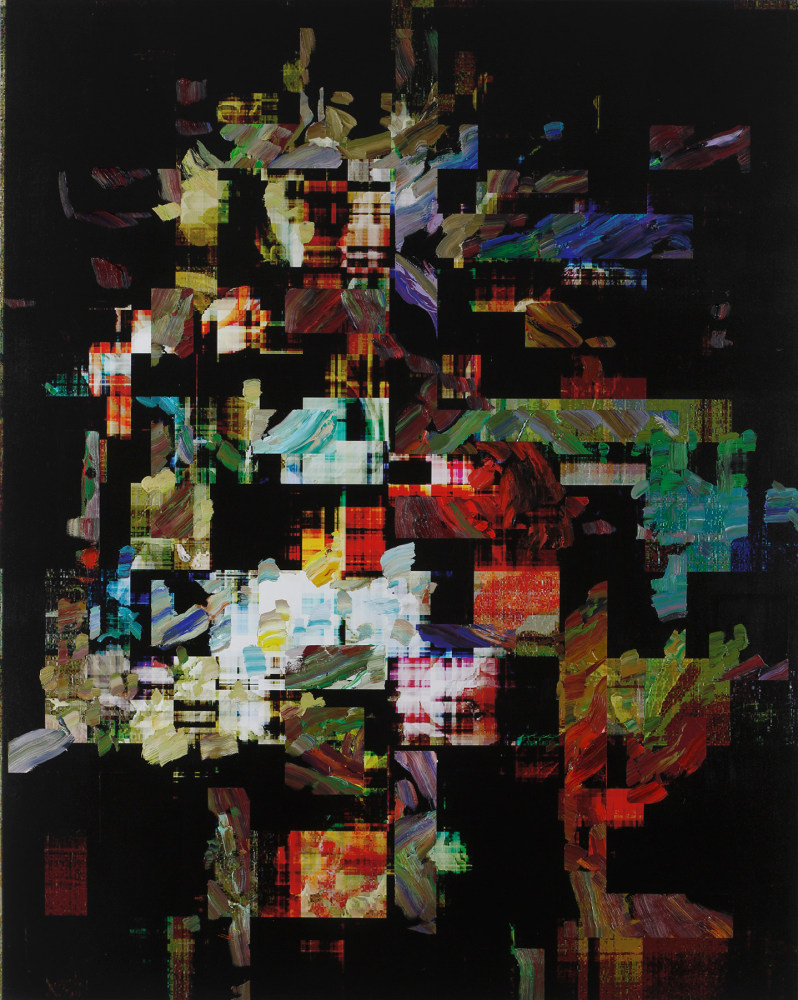
TIFFANY CALVERT
#338, 2019
oil on inkjet print on canvas
60h x 48w in
LOUISVILLE, Kentucky — In February 2019, I participated in the 47th Louisville Conference on Literature and Culture Since 1900. While I was there, I met Miranda Lash, Curator of Contemporary Art at the Speed Museum, who graciously gave me a tour of the collection, as well as brought me to various places in the city. Among the many things I experienced that day, one stood out for many reasons.
At the entrance to the European Paintings collection, on the walls flanking the doorway, the museum’s European Paintings curator, Erika Holmquist-Wall, had placed two recent paintings by Tiffany Calvert. Calvert had been a graduate student at the Mason Gross School of the Arts (Rutgers University), where I have been teaching since 2002, and her work reminded me of the heated debate about painting that divided the faculty at the time I was hired.
This is the wall label that Holmquist-Wall wrote for the two paintings, “#296” (2017, oil on inkjet print on canvas, 48 by 60 inches) and “#289” (2017, oil on inkjet print on canvas, 48 by 60 inches):
Merging Past and Present
As an artist, Tiffany Calvert applies contemporary painting techniques to historical imagery. Her recent work uses the seventeenth-century Dutch floral still life as a springboard for exploring the shifting nature of human perception. […] The paintings on display here are oil paintings on printed reproductions of a work by Dutch artist P. W. Windtraken. Calvert has intervened by matching paint to Windtraken’s original color palette, camouflaging it within the picture. Other techniques such as gridding, fragmentation, and image reversal serve to obstruct and interrupt the viewer’s perception of the image. Like a digital “glitch” or a scrambled transmission, Calvert generates paintings that are suspended in a moment, simultaneously on the verge of disintegration or cohesion.
I was interested in the difference between the two paintings. While “#289” made an obvious reference to a computer glitch, or what Holmquist-Wall called a “scrambled transmission,” I saw the horizontal and vertical patches of the glitch as evoking Piet Mondrian’s “Plus & Minus” works.
Calvert’s intervention in “#296” seemed more respectful of the original image than “#289,” which I felt was too dependent on the “scrambled transmission” for its effects. In “#296,” the paint was strong enough in its intervention. At the same time, it was clear to me that Calvert was in pursuit of something that she had not foreclosed upon, and that her interventions had not hardened into a style that leveled the differences between her sources
I kept wondering what motivated Calvert to make the decisions that led her to painting over the inkjet print of a 17th-century Dutch floral still life. I also knew that I was returning Louisville in February 2020 to attend the conference again, and that I would request a visit to her studio to ask her directly.
In the meantime, I speculated about the role that the debate over painting and its death might have played in these works, as there are artists who paint and those who use paint. Knowing the work that Calvert did as a grad student, I guessed that she associates with the artists who paint, but not without some skepticism.
[...]